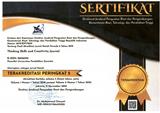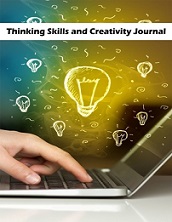Preliminary Stage: Student Worksheets Oriented to Higher Order Thinking Skills Based on Learning Styles
DOI:
https://doi.org/10.23887/tscj.v6i2.62574Keywords:
Critical Reasoning, Critical Reasoning, Learning Style-Based Learning Media, Science Learning, Science LearningAbstract
The demands of industry 4.0 are moving towards social society 5.0 to purpose education must be ready. Based on PISA in 2019, Indonesia has low performance quadrant with high equity, means that opportunity to improve critical thinking skills because it has underdeveloped capacity and potential to face the 21st century. Based on the results of survey with teachers and students, researchers found that the unavailability of worksheets base learning styles caused decreasing the student learning interest. This study aims to produce worksheets oriented to higher order thinking skills based on their learning styles. This type of research is development research using the 4D model. The research subjects were 32 even semester VIII grade students and 1 Science teacher at Manbaul Ulum. This research is limited to the analysis stage of school needs towards the development of worksheets oriented to higher order thinking skills based on learning styles using survey techniques. The results of the study show that worksheets that are oriented towards higher order thinking skills based on learning styles need to be developed to train critical thinking skills.
References
Alaloul, W. S., Liew, M. S., Zawawi, N. A. W. A., & Kennedy, I. B. (2020). Industrial revolution 4.0 in the construction industry: Challenges and opportunities for stakeholders. Ain Shams Engineering Journal, 11(1), 225–230. https://doi.org/10.1016/j.asej.2019.08.01. DOI: https://doi.org/10.1016/j.asej.2019.08.010
Anagün, S. S. (2018). Teachers’ Perceptions about the Relationship between 21st Century Skills and Managing Constructivist Learning Environments. International Journal of Instruction, 11(4), 825–840. https://doi.org/10.12973/iji.2018.11452a. DOI: https://doi.org/10.12973/iji.2018.11452a
Anam, C. (2020). Deskripsi Kemampuan Berfikir Kritis Siswa Terhadap Implementasi Kurikulum 2013 Pada Pembelajaran Tematik. Proceeding International Conference on Islamic Education, 5(1), 35–39. http://conferences.uin-malang.ac.id/index.php/icied/article/view/1224.
Aprilianingrum, D., & Wardani, K. W. (n.d.). Meta Analisis: Komparasi Pengaruh Model Pembelajaran Problem Based Learning dan Discovery Learning dalam Meningkatkan Kemampuan Berpikir Kritis Siswa SD. Jurna Basicedu, 5(2), 1006–1017. https://doi.org/10.31004/basicedu.v5i2.871. DOI: https://doi.org/10.31004/basicedu.v5i2.871
Baidillah, I. (2021). Penerapan Problem Based Learning Dalam Kerangka Lesson Study Untuk Meningkatkan Kemampuan Berpikir Kritis Dan Hasil Belajar Akuntansi Siswa. Journal of Accounting and Business Education, 2(4). https://doi.org/10.26675/jabe.v2i4.6074. DOI: https://doi.org/10.26675/jabe.v2i4.6074
Bystrova, T. (2020). Infographics As a Tool for Improving Effectiveness of Education. KnE Social Sciences, 2020, 152–158. https://doi.org/10.18502/kss.v4i13.7710. DOI: https://doi.org/10.18502/kss.v4i13.7710
Dewi, N. P. D. M., & Agustika, G. N. S. (2022). E-LKPD Interaktif berbasis Etnomatematika Jejahitan Bali pada Materi Bangun Datar Kelas IV SD. Mimbar PGSD Undikhsa, 10(1), 94–104. https://doi.org/10.23887/jjpgsd.v10i1.45350. DOI: https://doi.org/10.23887/jjpgsd.v10i1.45350
Dewi, R. S. (2020). Penggunaan Lembar Kerja Siswa (LKS) Berbantuan Media Audio Visual Dalam Pembelajaran IPA-Biologi Pada Pokok Bahasan Struktur Dan Fungsi Jaringan Tumbuhan Sebagai Upaya Meningkatkan Hasil Belajar di MTs Negeri 5 Kota Jambi. Jurnal Literasiologi, 4(2). https://jurnal.literasikitaindonesia.com/index.php/literasiologi/article/view/139/158. DOI: https://doi.org/10.47783/literasiologi.v4i2.139
Ellerton, P. (2022). On critical thinking and content knowledge: A critique of the assumptions of cognitive load theory. Thinking Skills and Creativity, 43, 100975. https://doi.org/10.1016/j.tsc.2021.100975. DOI: https://doi.org/10.1016/j.tsc.2021.100975
Fatimah, A. S., & Santiana, S. (2017). Teaching in 21St Century: Students-Teachers’ Perceptions of Technology Use in the Classroom. Script Journal: Journal of Linguistic and English Teaching, 2(2), 125. https://doi.org/10.24903/sj.v2i2.132. DOI: https://doi.org/10.24903/sj.v2i2.132
Fitria, A., Wijaya, M., & Danial, M. (2019). Pengembangan Lembar Kerja Peserta Didik (LKPD) Berbasis High Order Thinking Skill (HOTS) Pada Materi Tabel Periodik Unsur. Journal of Chemical Information and Modeling, 53(9), 2. http://eprints.unm.ac.id/17064. DOI: https://doi.org/10.26858/cer.v3i2.13767
Fraenkel, J. R., Wallen, N. E., & Hyun, H. H. (2012). How to design and evaluate research in education (8th ed.). The McGraw-Hill Companies.
Gilakjani, A. P. (2012). A Match or Mismatch Between Learning Styles of the Learners and Teaching Styles of the teachers. Modern Education and Computer Science, 11, 51–60. https://doi.org/10.5815/ijmecs.2012.11.05. DOI: https://doi.org/10.5815/ijmecs.2012.11.05
Grant. (2019). MM Difficulties in defining mobile learning: Analysis, design characteristics-tics, and implications. Educational Technology Research and Development, 67(2), 361–388,. https://doi.org/10.1007/s11423-018-09641-4. DOI: https://doi.org/10.1007/s11423-018-09641-4
Gupta, T., Burke, K. A., & Greenbowe, T. J. (2022). Shifting the ownership of learning from instructor to students through student-led instructor-facilitated guided-inquiry learning. In Teaching Innovation in University Education: Case Studies and Main Practices, 69–98. https://doi.org/10.4018/978-1-6684-4441-2.ch005. DOI: https://doi.org/10.4018/978-1-6684-4441-2.ch005
Ibrahem, U. M., & Alamro, A. R. (2020). Effects of Infographics on Developing Computer Knowledge, Skills and Achievement Motivation among Hail University Students. International Journal of Instruction, 14(1), 907–926. https://doi.org/10.29333/IJI.2021.14154A. DOI: https://doi.org/10.29333/iji.2021.14154a
Kurniaman, O., & Noviana, E. (2017). Penerapan Kurikulum 2013 Dalam Meningkatkan Keterampilan, Sikap, Dan Pengetahuan. Primary: Jurnal Pendidikan Guru Sekolah Dasar, 6(2), 389. https://doi.org/10.33578/jpfkip.v6i2.4520. DOI: https://doi.org/10.33578/jpfkip.v6i2.4520
Parvathamma, N., & Pattar, D. (2013). Digital literacy among student community in management institutes in Davanagere District, Karnataka State, India. Annals of Library and Information Studies (ALIS), 60(3), 159–166. https://doi.org/10.56042/alis.v60i3.863.
Pitt, V., Powis, D., Levett-Jones, T., & Hunter, S. (2015). The influence of critical thinking skills on performance and progression in a pre-registration nursing program. Nurse Education Today, 35(1), 125–131. https://doi.org/10.1016/j.nedt.2014.08.006. DOI: https://doi.org/10.1016/j.nedt.2014.08.006
Prastowo, A. (2015). Panduan Kreatif Membuat Bahan Ajar Inovatif. Diva Press.
Pratiwi, B., & Puspito Hapsari, K. (2020). Analisis Kemampuan Berpikir Tingkat Tinggi Melalui Pemanfaatan YouTube Sebagai Media Pembelajaran Bahasa Indonesia. Jurnal Ilmiah Sekolah Dasar, 4(2), 282. https://doi.org/10.23887/jisd.v4i2.24238. DOI: https://doi.org/10.23887/jisd.v4i2.24238
Putri, F. E., Amelia, F., & Gusmania, Y. (2019). Hubungan Antara Gaya Belajar dan Keaktifan Belajar Matematika Terhadap Hasil Belajar Siswa. EDUMATIKA: Jurnal Riset Pendidikan Matematika, 2(2), 83–88. https://doi.org/10.32939/ejrpm.v2i2.406. DOI: https://doi.org/10.32939/ejrpm.v2i2.406
Putri Ningrat, S., Tegeh, I. M., & Sumantri, M. (2018). Kontribusi Gaya Belajar Dan Motivasi Belajar Terhadap Hasil Belajar Bahasa Indonesia. Jurnal Ilmiah Sekolah Dasar, 2(3), 257. https://doi.org/10.23887/jisd.v2i3.16140. DOI: https://doi.org/10.23887/jisd.v2i3.16140
Raharjo, H., Khairudin, M., & Baser, J. A. (2018). The Influence of Problem-based Learning and Direct Teaching on Students’ Learning Outcomes. Jurnal Pendidikan Teknologi Dan Kejuruan, 24(1), 62–71. https://doi.org/10.21831/jptk.v24i1.18015. DOI: https://doi.org/10.21831/jptk.v24i1.18015
Rahayu, R., Iskandar, S., & Abidin, Y. (2022). Inovasi pembelajaran abad 21 dan penerapannya di Indonesia. Jurnal Basicedu, 6(2), 2099–2104. https://doi.org/10.31004/basicedu.v6i2.2082. DOI: https://doi.org/10.31004/basicedu.v6i2.2082
Saraswati, P. M. S., & Agustika, G. N. S. (2020). Kemampuan berpikir tingkat tinggi dalam menyelesaikan soal HOTS mata pelajaran matematika. Jurnal Ilmiah Sekolah Dasar, 4(2), 257–269. https://doi.org/10.23887/jisd.v4i2.25336. DOI: https://doi.org/10.23887/jisd.v4i2.25336
Sari, S. M., A.A., & Hussin, N. (2019). Persepsi Guru Kimia Mengenai Keterampilan Abad 21. Skripsi, 12-22Shahroom. International Journal of Academic Research in Business and Social Sciences, 8(9), 314–319. https://doi.org/10.6007/ijarbss/v8-i9/4593.
Seibert, S. A. (2020). Problem-based learing: A strategy to foster generation Z’s critical thinking and perseverance. Teaching and Learning in Nursing, 000, 2–5. https://doi.org/10.1016/j.teln.2020.09.002. DOI: https://doi.org/10.1016/j.teln.2020.09.002
Shahroom, A. A., & Hussin, N. (2018). Industrial Revolution 4.0 and Education. International Journal of Academic Research in Business and Social Sciences, 8(9). https://doi.org/10.6007/ijarbss/v8-i9/4593. DOI: https://doi.org/10.6007/IJARBSS/v8-i9/4593
Sugiyono. (2012). Metode Penelitian Kuantitatif Kualitatif dan R&B. Alfabeta.
Surur, M., Degeng, I. N. S., Setyosari, P., & Kuswandi, D. (2020). The Effect of Problem-Based Learning Strategies and Cognitive Styles on. International Journal of Instruction, 13(4), 35–48. https://eric.ed.gov/?id=EJ1270824. DOI: https://doi.org/10.29333/iji.2020.1343a
Sutarto, & Syarifuddin. (2013). Desain Pembelajaran Matematika. Samudra Biru.
Widarti, H. R., Rokhim, D. A., & Syafruddin, A. B. (2020). The Development Of Electrolysis Cell Teaching Material Based On Stem-Pjbl Approach Assisted By Learning Video: A Need Analysis. Jurnal Pendidikan IPA Indonesia, 9(3), 309–318. https://doi.org/10.15294/jpii.v9i3.25199.
Widiyanti, I., Putra, P. D. A., & Anggraeni, F. K. A. (2021). Pengembangan Ukbm Dengan Pendekatan Engineering Design Process (Edp) Untuk Meningkatkan Literasi Stem Siswa Sma. Jurnal Pembelajaran Fisika, 10(3), 83. https://doi.org/10.19184/jpf.v10i3.25272. DOI: https://doi.org/10.19184/jpf.v10i3.25272
Winarni, R., Slamet, S. Y., & Syawaludin, A. (2022). Development of Indonesian language text books with multiculturalism and character education to improve traditional poetry writing skills. European Journal of Educational Research, 10(1), 455–466. https://doi.org/10.12973/EU-JER.10.1.455. DOI: https://doi.org/10.12973/eu-jer.10.1.455









